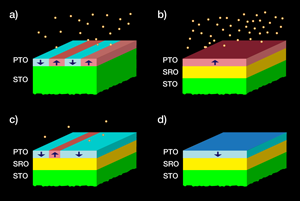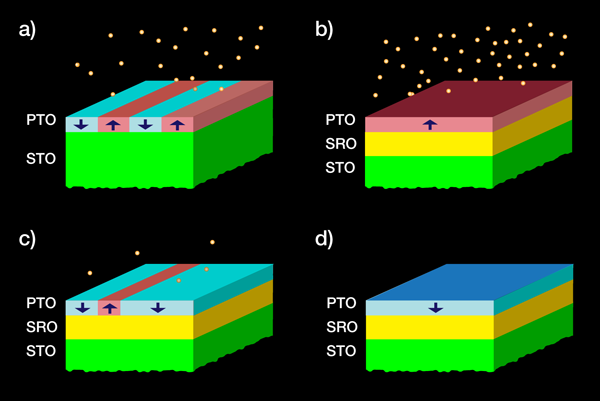Switching a ferroelectric film by asphyxiation
In a ferroelectric material, the spontaneous electric polarization can be reversed upon application of an electric field. It is now well established that an arbitrarily thin ferroelectric slab can sustain a spontaneous polarization. However, the polarization state of a very thin film without a covering electrode layer is extremely sensitive to the environment. Experimental work published in Physical Review Letters by a collaboration of authors from Argonne National Laboratory, Northern Illinois University, and the University of Pennsylvania [1] now shows that a ferroelectric film can be reversibly and reproducibly switched between an outward to an inward polarized state by varying the partial oxygen pressure above its free surface. This means that the chemical environment can affect even very fine structural properties of ferroelectric nanostructures. Such effects can have important technological and scientific implications.
To explain these results, we need to consider the bound surface charge given by the normal component of the spontaneous polarization [2]. When the film thickness is smaller than the intrinsic screening length of the ferroelectric material, the bound charge can still be compensated for from outside, e.g., by free carriers in the adjacent electrodes. However, if such a charge compensation is prevented as well, the only way in which the ferroelectricity can be maintained is by arranging the polarization into a sufficiently fine nanodomain pattern, for which the overall depolarization field energy is small enough.
The experiments of Wang et al. [1] were carried out with - to -thick films of , grown epitaxially on a (100)-oriented substrate covered by of metal electrode (see Fig. 1). The substrate imposes compressive strain into the film, such that the polarization is forced to be perpendicular to the film and thus bound charges are formed on its top and bottom surfaces. The top surface is compensated by ions from the environment [4], and the bottom interface by electrons from the conductive electrode. When such ferroelectric films are grown directly on a nonconductive substrate, the bottom surface charge is uncompensated and a fine antiparallel stripe nanodomain pattern is systematically observed [3] in as-grown films [see Fig. 1(a)].
Conversion of stripe domain structures to monodomain has been demonstrated by photochemical treatment [5] or cooling in the presence of x rays [3]. However, in this study, Wang et al. try to influence the polarization of the film by controlling the partial oxygen pressure above the film [1]. Films grown in an oxidizing atmosphere, with a high partial oxygen pressure, show the uniform outward polarization [Fig. 1(b)]. Subsequent equilibration at lower and lower partial pressures gradually causes reentrance of the domain structure [Fig. 1(c)]. Typically, the pressure has to be lowered by about four orders of magnitude to recover the nanodomain state with compensated average polarization.
Most remarkably, their films that were equilibrated at ultralow oxygen pressures of order of are in the inward polarized state [Fig. 1(d)]. When the partial oxygen pressure is then increased, the film can be returned to the nanodomain and outward polarized states. In this opposite sequence, the compensated polarization state [as in Fig. 1(a)] is reached at about three orders of magnitude higher pressure value. Consequently, the observed polarization-log[ ] diagram (see Fig. 2(c) of Ref. [1]) reminds one of the polarization-electric field hysteresis loop of a ferroelectric; in fact, the whole cycle is well reproducible. In other words, this effect is analogous to field-induced switching.
To investigate the polarization of the films, experiments were performed at the synchrotron beamline of the Advanced Photon Source, where grazing incidence x-ray investigations of such films can be performed in situ during their growth and processing. The outward and inward uniform polarization were distinguished by a slight difference in the intensity of the (304) reflection of , due to the resonant scattering, and also by the difference of weak x-ray fringe patterns caused by interferences with the adjacent and layers. In addition, a structural reconstruction of the top surface atomic layer, distinct for the inward and the outward uniformly polarized case, was noticed in the experiment and confirmed by quantum-mechanical (density functional) theory calculations [1]. Interestingly, the best structural model for the surface reconstruction in the inward polarized state involves one oxygen vacancy per four unit cells; this density of oxygen vacancies is just sufficient to compensate the bound charge associated with inward spontaneous polarization.
Wang et al. [1] suggest these findings could have applications for chemical actuators and catalysis. The modified surface reconstruction or polarization reversal could perhaps also facilitate growth of some more complex multilayer films. Primarily, however, these results represent a beautiful lesson about the importance of the surfaces and interfaces for nanoscale ferroelectrics: their properties can be changed by modifying a single atomic layer, through chemistry. More such effects might be predicted using first-principle-based atomistic calculations, and these may be promising for ferroelectric nanotechnology. One does not need to go far to investigate such important interfaces. After all, even the usual fine-grain ferroelectric ceramics are full of atomically thin grain boundaries where such effects could occur.
Note added by author (13 February 2009): The authors of [1] have pointed out some inaccuracies in the original version of this commentary. Figure 1(a), its captions, and portions of the text have been revised to indicate that the films with stripe domains studied in [3] and [5] were grown directly on substrates.
References
- R. V. Wang, D. D. Fong, F. Jiang, M. J. Highland, P. H. Fuoss, C. Thompson, A. M. Kolpak, J. A. Eastman, S. K. Streiffer, A. M. Rappe, and G. B. Stephenson, Phys. Rev. Lett. 102, 047601 (2009)
- Ph. Ghosez and K. M. Rabe, Appl. Phys. Lett. 76, 2767 (2000); S. Tinte and M. G. Stachiotti, Phys. Rev. B 64, 235403 (2001); M. Dawber, P. Chandra, P. B. Littlewood, and J. F. Scott, J. Phys.: Cond. Mat. 15, L393 (2003); C. Lichtensteiger, J. M. Triscone, J. Junquera, and Ph. Ghosez, Phys. Rev. Lett. 94, 047603 (2005); I. Ponomareva, I. I. Naumov, I. Kornev, H. Fu, and L. Bellaiche, Phys. Rev. B 72, 140102 (2005); G. Gerra, A. K. Tagantsev, and N. Setter, Phys. Rev. Lett. 98, 207601 (2007)
- S. K. Streiffer, J. A. Eastman, D. D. Fong, C. Thompson, A. Munkholm, M. V. R. Murty, O. Auciello, G. R. Bai, and G. B. Stephenson, Phys. Rev. Lett. 89, 067601 (2002)
- D. D. Fong, A. M. Kolpak, J. A. Eastman, S. K. Streiffer, P. H. Fuoss, G. B. Stephenson, C. Thompson, D. M. Kim, K. J. Choi, C. B. Eom, I. Grinberg, and A. M. Rappe, Phys. Rev. Lett. 96, 127601 (2006)
- R. Takahashi, J. K. Grepstad, T. Tybell, and Y. Matsumoto, Appl. Phys. Lett. 92, 112901 (2008)





